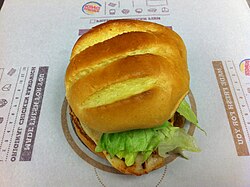 The North American version of the TenderGrill burger, as of November 2013 | |||||||||||
| Nutritional value per 1 burger (425 g) | |||||||||||
|---|---|---|---|---|---|---|---|---|---|---|---|
| Energy | 510 kcal (2,100 kJ) | ||||||||||
49 g | |||||||||||
| Sugars | 15 g | ||||||||||
| Dietary fiber | 0 g | ||||||||||
19 g | |||||||||||
| Saturated | 3.5 g | ||||||||||
| Trans | 0.5 g | ||||||||||
37 g | |||||||||||
| |||||||||||
| Other constituents | Quantity | ||||||||||
| Energy from fat | 124 kcal (520 kJ) | ||||||||||
| Cholesterol | 76 mg | ||||||||||
May vary outside US market. | |||||||||||
| †Percentages estimated using US recommendations for adults,[1] except for potassium, which is estimated based on expert recommendation from the National Academies.[2] Source: www.BK.com (PDF) | |||||||||||
The fast-food restaurant chain Burger King was the first major fast food chain to introduce a grilled chicken burger to the marketplace, in 1990, six months before Wendy's and four years before McDonald's. Since then, Burger King, and its Australian franchise Hungry Jack's have offered a variety of grilled chicken burgers, as have Wendy's and McDonald's.
Their first grilled chicken burger, the BK Broiler, was one of the most successful product introductions in the fast food industry ever. It was reformulated as the Chicken Whopper (2002), named after their Whopper burger. That was replaced by the BK Baguette (2004), promoted as health-oriented, which was in turn replaced with the larger, meatier TenderGrill burger (2005), targeted to more sophisticated, adult customers, notably 24- to 36-year-old males.
The company sells different variants in different markets, using white meat chicken breast in some regions while using dark meat chicken thighs in others.
- ^ United States Food and Drug Administration (2024). "Daily Value on the Nutrition and Supplement Facts Labels". FDA. Archived from the original on March 27, 2024. Retrieved March 28, 2024.
- ^ National Academies of Sciences, Engineering, and Medicine; Health and Medicine Division; Food and Nutrition Board; Committee to Review the Dietary Reference Intakes for Sodium and Potassium (2019). "Chapter 4: Potassium: Dietary Reference Intakes for Adequacy". In Oria, Maria; Harrison, Meghan; Stallings, Virginia A. (eds.). Dietary Reference Intakes for Sodium and Potassium. The National Academies Collection: Reports funded by National Institutes of Health. Washington, DC: National Academies Press (US). pp. 120–121. doi:10.17226/25353. ISBN 978-0-309-48834-1. PMID 30844154. Retrieved December 5, 2024.
